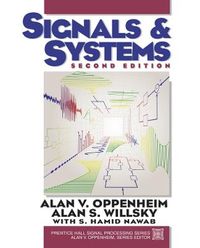
1 säljare
Signals and Systems Upplaga 2
This comprehensive exploration of signals and systems develops continuous- time and discrete-time concepts/methods in parallel highlighting the similarities and differences and features introductory treatments of the applications of these basic methods in such areas as filtering, communication, sampling, discrete-time processing of continuous-time signals, and feedback. Relatively self-contained, the book assumes no prior experience with system analysis, convolution, Fourier analysis, or Laplace and z-transforms.
FEATURES:
Develops continuous-time and discrete-time concepts in parallel highlighting the similarities and differences. E.g.: Ch. 1 on basic signals and system properties, Ch. 2 on linear time-invariant systems, and Ch. 3 on Fourier series representation each develop the continuous-time and discrete-time concepts in parallel. Ch. 9 on the Laplace Transform and Ch. 10 on the Z-transform deal with the two domains separately, but often draw parallels between results in the two domains. Introduces some of the important uses of the basic methods that are developed e.g., filtering, communication, sampling, discrete-time processing of continuous-time signals, and feedback. NEWA companion book contains MATLAB-based computer exercises for each topic. NEWMaterial on Fourier analysis has been reorganized significantly to provide an easier path for the reader to master and appreciate the importance of this topic. Now represented in four chapters, each of which is far more streamlined and focused, introducing a smaller and more cohesive set of topics. NEWFrequency-domain filtering is introduced very early in the development to provide a central and concrete illustration of why this topic is important and to provide some intuition with a minimal amount of mathematical preliminaries. NEWRelocates coverage of Sampling before Communication. * Allows for discussion of important forms of communication, namely those involving discrete or digital signals, in which sampling concepts are intimately involved. NEWChapter-end Problems They provide a better balance between exercises developing basic skills and understanding ones that pursue more advanced problem-solving skills. The new edition organizes chapter-end problems into four types of sections which makes it easier for the reader to locate the problems that will best serve their purposes; and provides two types of basic problems, ones with answers (but not solutions); and ones with solutions to provide immediate feedback, while attempting to master the material.
The four types of chapter-end problems are Basic Problems with Answers. Basic Problems. Advanced Problems. Extension Problems.
Upplaga: 2a upplagan
Utgiven: 1997
ISBN: 9780136511755
Förlag: Prentice Hall
Format: Häftad
Språk: Engelska
Sidor: 957 st
This comprehensive exploration of signals and systems develops continuous- time and discrete-time concepts/methods in parallel highlighting the similarities and differences and features introductory treatments of the applications of these basic methods in such areas as filtering, communication, sampling, discrete-time processing of continuous-time signals, and feedback. Relatively self-contained, the book assumes no prior experience with system analysis, convolution, Fourier analysis, or Laplace and z-transforms.
FEATURES:
Develops continuous-time and discrete-time concepts in parallel highlighting the similarities and differences. E.g.: Ch. 1 on basic signals and system properties, Ch. 2 on linear time-invariant systems, and Ch. 3 on Fourier series representation each develop the continuous-time and discrete-time concepts in parallel. Ch. 9 on the Laplace Transform and Ch. 10 on the Z-transform deal with the two domains separately, but often draw parallels between results in the two domains. Introduces some of the important uses of the basic methods that are developed e.g., filtering, communication, sampling, discrete-time processing of continuous-time signals, and feedback. NEWA companion book contains MATLAB-based computer exercises for each topic. NEWMaterial on Fourier analysis has been reorganized significantly to provide an easier path for the reader to master and appreciate the importance of this topic. Now represented in four chapters, each of which is far more streamlined and focused, introducing a smaller and more cohesive set of topics. NEWFrequency-domain filtering is introduced very early in the development to provide a central and concrete illustration of why this topic is important and to provide some intuition with a minimal amount of mathematical preliminaries. NEWRelocates coverage of Sampling before Communication. * Allows for discussion of important forms of communication, namely those involving discrete or digital signals, in which sampling concepts are intimately involved. NEWChapter-end Problems They provide a better balance between exercises developing basic skills and understanding ones that pursue more advanced problem-solving skills. The new edition organizes chapter-end problems into four types of sections which makes it easier for the reader to locate the problems that will best serve their purposes; and provides two types of basic problems, ones with answers (but not solutions); and ones with solutions to provide immediate feedback, while attempting to master the material.
The four types of chapter-end problems are Basic Problems with Answers. Basic Problems. Advanced Problems. Extension Problems.
Begagnad bok
485 kr
Fri frakt & skickas inom 1-3 vardagar
Köpskydd med Studentapan
Varje köp täcks av Studentapans köpskydd som säkerställer att boken kommer fram, att du får rätt bok och att skicket stämmer överens med beskrivning.



